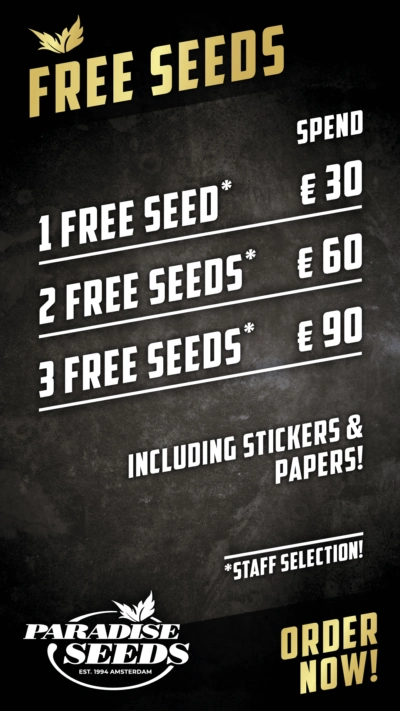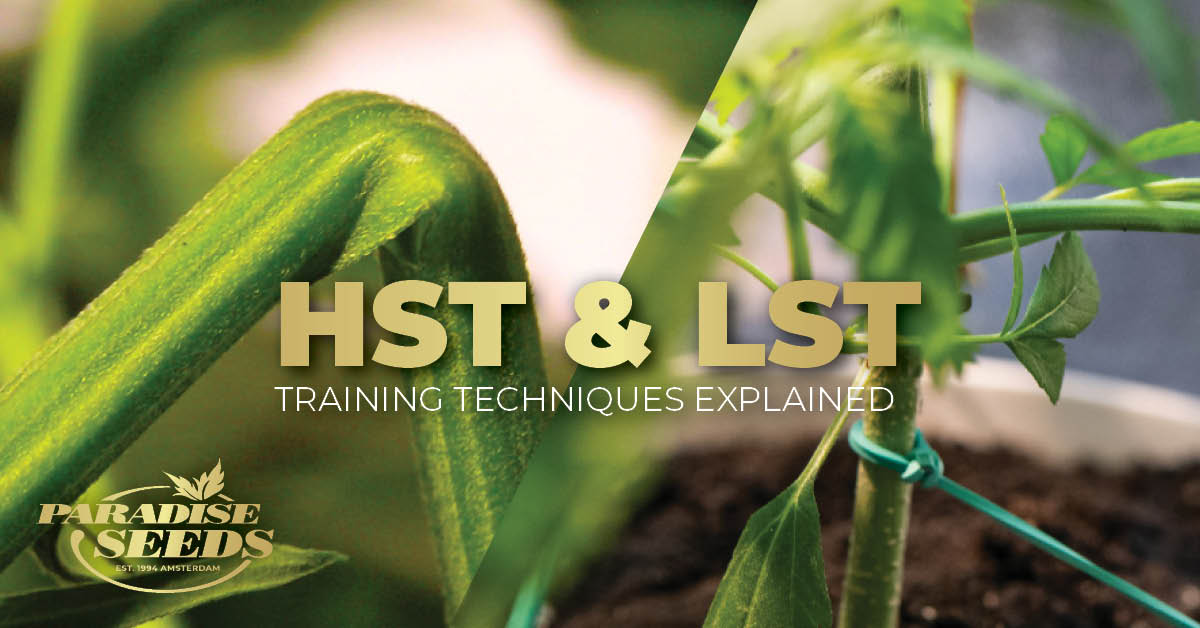Cannabis plants are incredibly adaptable during the vegetative stage, providing a window of opportunity to practice LST and HST cannabis training methods. The reason for using these techniques is to manage plants and increase yield potential.
HST is the commonly used term to describe High Stress Training, while LST refers to Low Stress Training. Each method has its advantages, although HST is not recommended for beginners as it requires a good knowledge of working with cannabis plants.
Nevertheless, there are benefits to using training techniques and they are now common practice amongst growers.
Contents
Why consider LST or HST Training for weed plants?
These techniques are more traditionally associated with indoor grow room practices, but they also have their advantages when used in outdoor growing. The most common reasons for using LST and HST are:
- To aid management of a grow space, especially one with restricted height.
- To promote lateral (horizontal) growth of branches to increase bud sites.
- To create better light distribution to allow better all round bud development.
- To improve airflow and reduce the risk of conditions such as mold.
- To camouflage outdoor plants by creating a less conspicuous growth pattern.
In this article we will take a look at both LST and HST training techniques, describe the most popular means of achieving them and give tips on how to avoid common problems.
What are the LST and HST cannabis training techniques?
Both LST and HST cannabis training routes serve the same purpose – to apply controlled ‘stress’ to the plant in order to manipulate its shape. This results in more compact plants which have their growth energy focused more efficiently into bud site development.
Can you use LST and HST with autoflowers?
This article is focused on photoperiod seeds, which tend to have an extended vegging period, making them more resilient to stress training techniques.
The window for applying LST and HST cannabis training methods in autos is only 4 – 5 weeks, before they naturally begin to flower. One HST practice often used is ‘topping’ (ie removing the top of the vertical stem to promote outward growth and this is fairly fool proof. However, without good knowledge of working with cannabis plants, and especially autoflowers, the recommended way to train, is to use LST for autoflowers.
What is LST (Low Stress Training)?
LST is the most plant friendly technique used to encourage the plant to grow in a different direction i.e. not straight up and vertical towards the light source. As the name suggests, it is a low stress manoeuvre for the plant and is also the most user friendly training technique for growers i.e. it’s hard to go wrong!
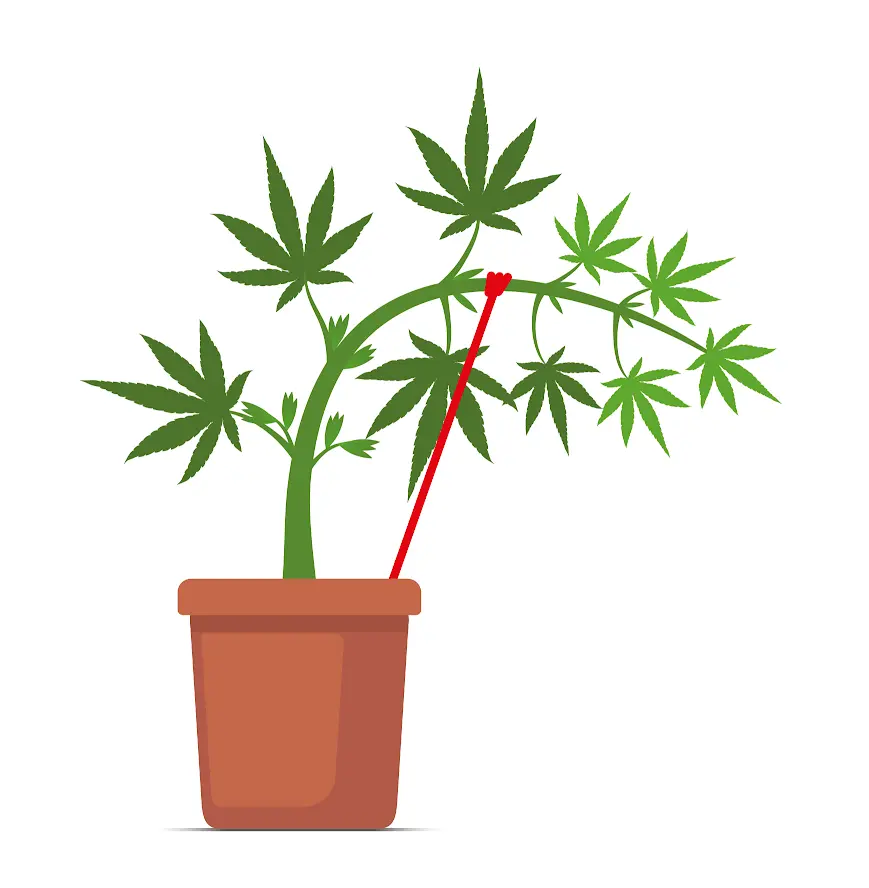
This is achieved by training the branches to grow horizontally in different directions to promote even coverage of bud development. It involves gentle manipulation and bending of branches, which are anchored using ties, to encourage them to grow in a different (usually horizontal) direction.
What is HST (High Stress Training)?
HST training performs the same role of manipulating plant structure and encouraging lateral growth, but it is far more aggressive in its nature and therefore more taxing on the plant. It often involves removing parts of the plant and for this reason growers need to be confident in their actions and also ‘know‘ their plants to avoid over stressing and causing potentially fatal damage.
When is the best time to use LST and HST training techniques?
The optimum time period for employing LST and HST cannabis training methods is during the vegetative stage, when the cannabis plant is receptive to manipulation, super malleable and, due to the vigorous growth during this life stage, most resilient to bouncing back from the stress caused.
Training can begin after a few weeks of veg stage, when the plant has developed 3 or 4 nodes (i.e. the little intersections where the stem branches off).
Good advice for planning training
Start LST and HST cannabis training with a plan i.e. what do you want it to achieve? Make sure your actions are purposeful and that you have prepared the right equipment for the task.
If you are applying training which requires repeated actions (such as tying down branches with LST) there needs to be a routine i.e. stressing actions need to be followed by two or three days of rest to help the plant recover.
What equipment is needed for LST and HST training?
To make the best job, using LST and HST cannabis training techniques, invest in some essential tools which will not only make the job easier, but also protect the health of the plant:
- Sharp scissors or specialist pruning shears to make those essential cuts as clean and clinical as possible.
- Gloves (disposable) to ensure that pests or diseases are not transmitted from other plants.
- Alcohol, Bleach or another suitable solution for sterilizing equipment.
- Garden soft wire for easy tying down of stems and branches.
- Stakes (BBQ stakes are perfect), for anchoring the soft wire to the stem. However, the plant isn’t fussy – string and even shoe laces work fine too (just tie loosely so the stem has room to grow).
- Water spray bottle is handy for hydrating the plant leaves or softening up soil if needed.
Now we have established the basics, let’s take a closer look at the specifics of LST and HST cannabis training techniques.
HST cannabis training methods
HST can be broken down into a handful of common training practices. These are mainlining, topping, fimming and super cropping.
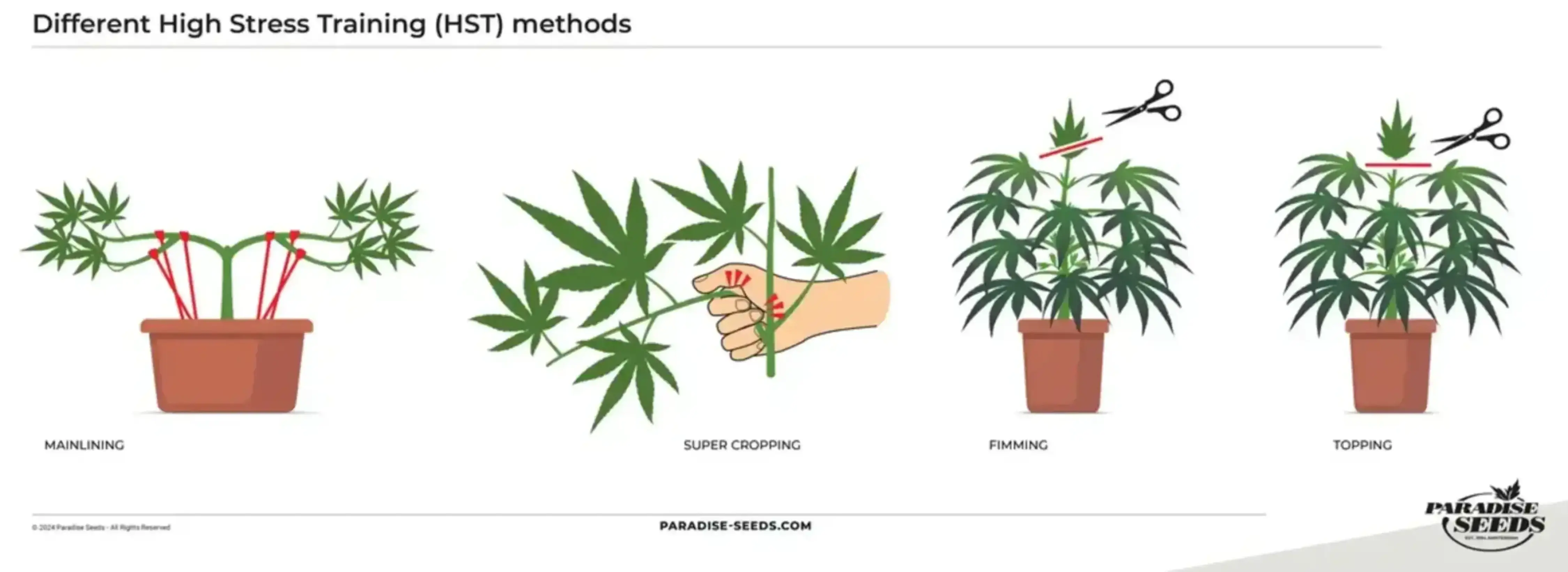
Topping
Topping is a technique which is used in both LST and HST cannabis training practices. It is a simple (one cut!) operation, which involves removing the top of the plant.
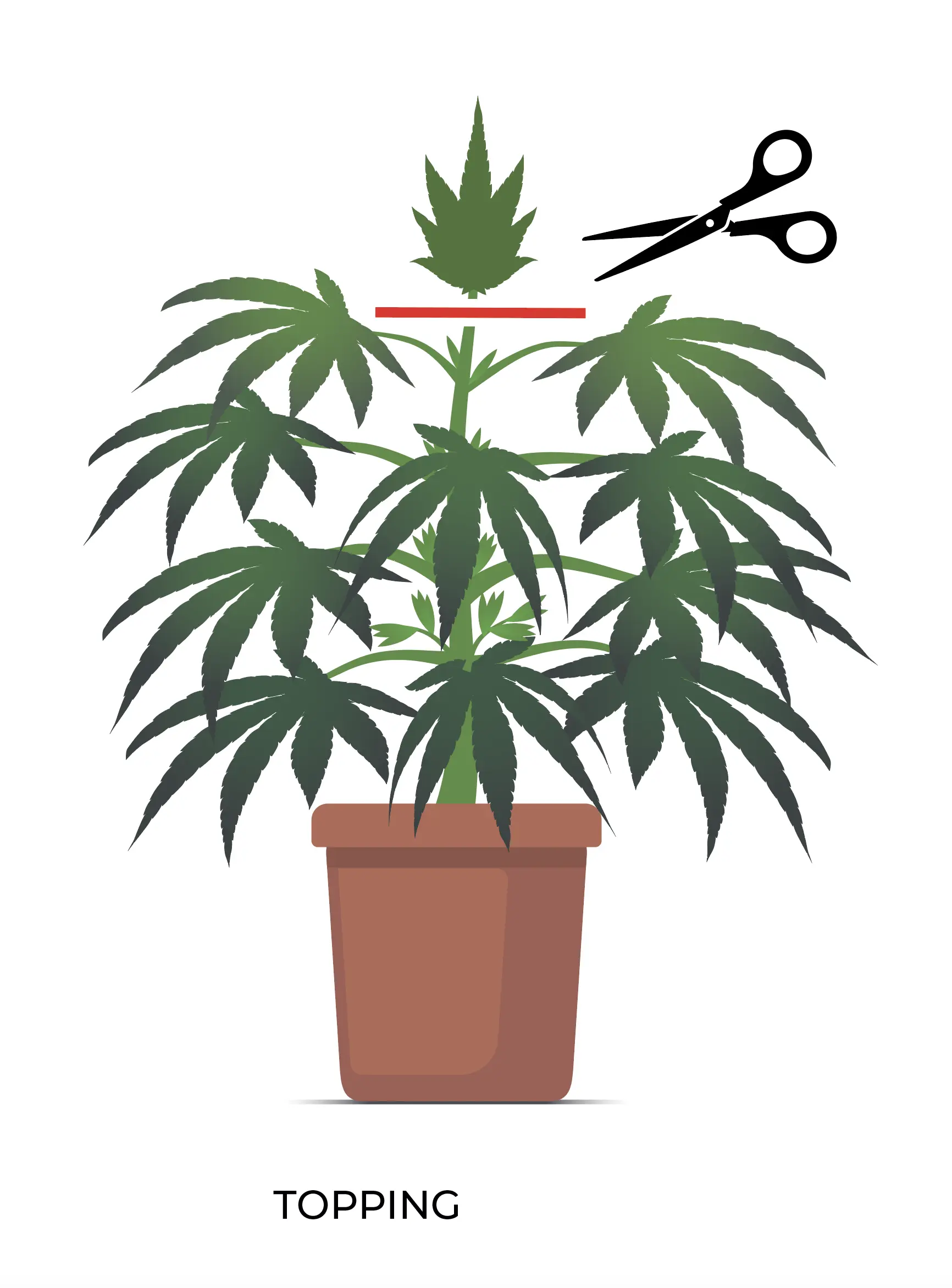
Why top a cannabis plant? The plant focuses its growth upwards, so by removing the top part that energy becomes channelled into side branches. The result is a more compact plant with lateral growth and more bud site development of medium sized chunky flowers.
For a comprehensive guide to topping, see this video from the Paradise Seeds Skunkworks series with the Topshelf Grower.
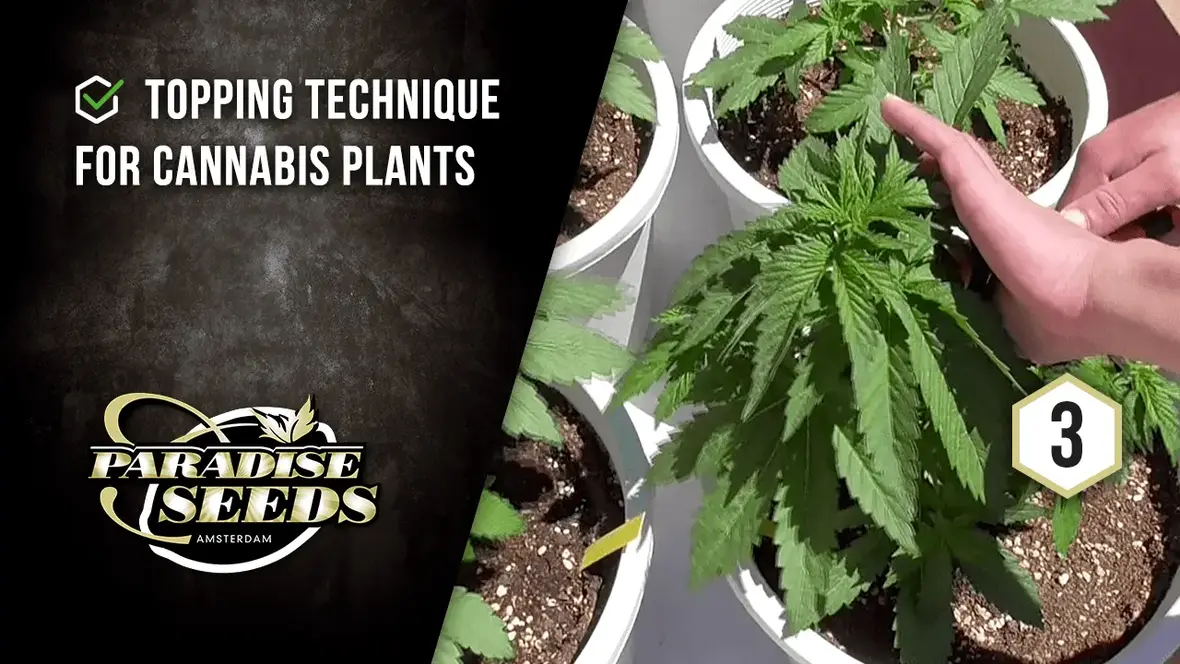
Fimming
Interesting fact, the fimming technique comes from the word ‘fim’, which is an acronym of “f**k, I missed!”, supposedly the phrase used when a topping operation had gone wrong!
The fimming technique is particularly used in a SCROG set up and, as suggested, is similar to topping, but instead of a clean cut, 30% of the top shoot is left remaining.
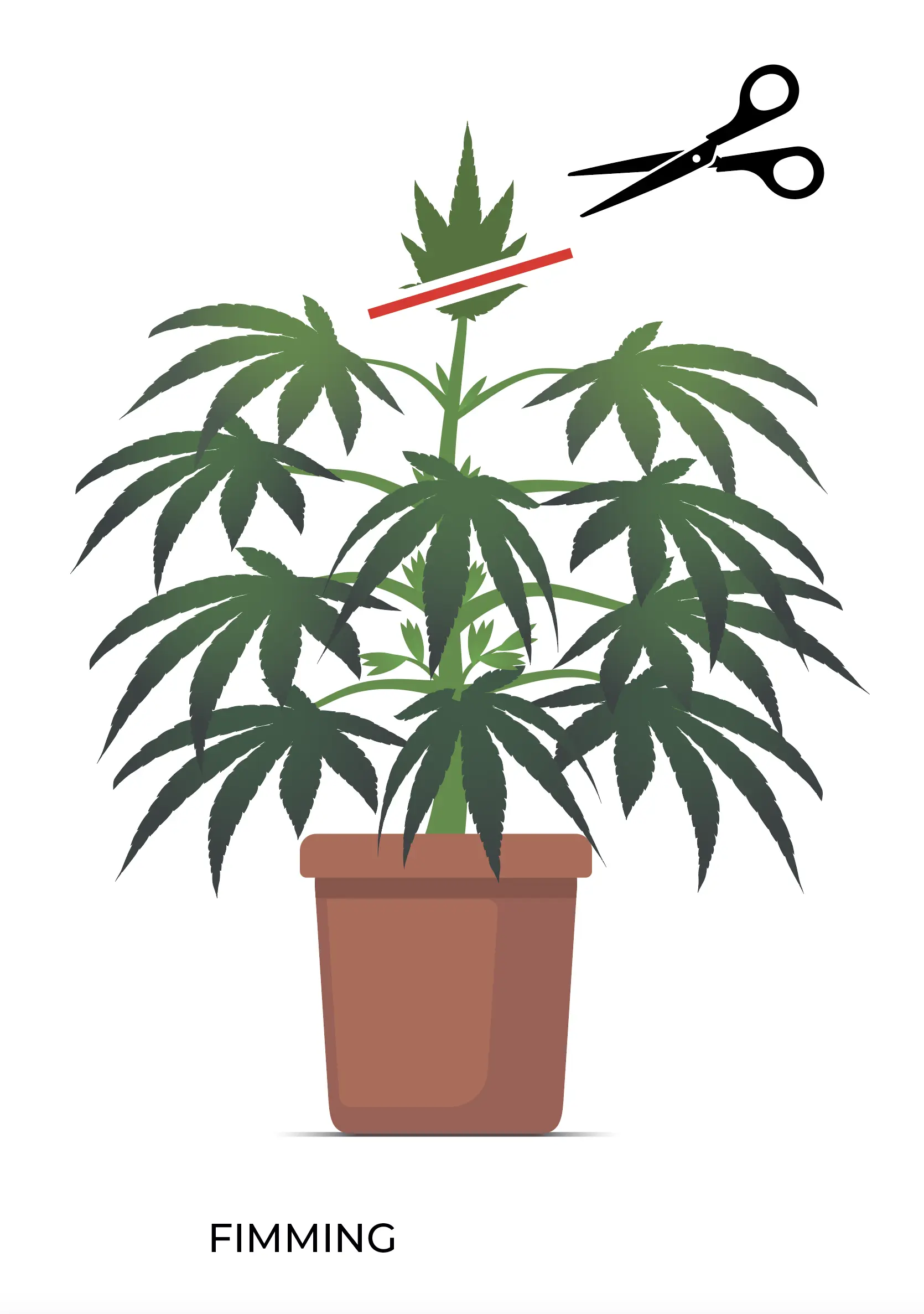
“F**k, I missed.”
Why FIM a cannabis plant? Similar to the topping technique, fimming will open up sideways cannabis plant growth and encourage bud site developments along branches. For an in-depth explanation of how to FIM with a step-by step guide, read more here.
Mainlining
Mainlining is a technique used to strictly control the structure of the cannabis plant by producing between two and eight ‘mainlines’ which run from a topped base.
The logic is that rather than having many branches with buds of varying quality, you groom the plant to produce these few branches with all its energy going into developing flower sites.
Mainlining is usually carried out when the plant is about 30cm tall and has developed 6 – 8 nodes i.e. it is a fit and healthy plant which can withstand the brutal cut to begin the mainline process. Its height is ‘topped’ to above the third or fourth node to create an initial ‘manifold’.
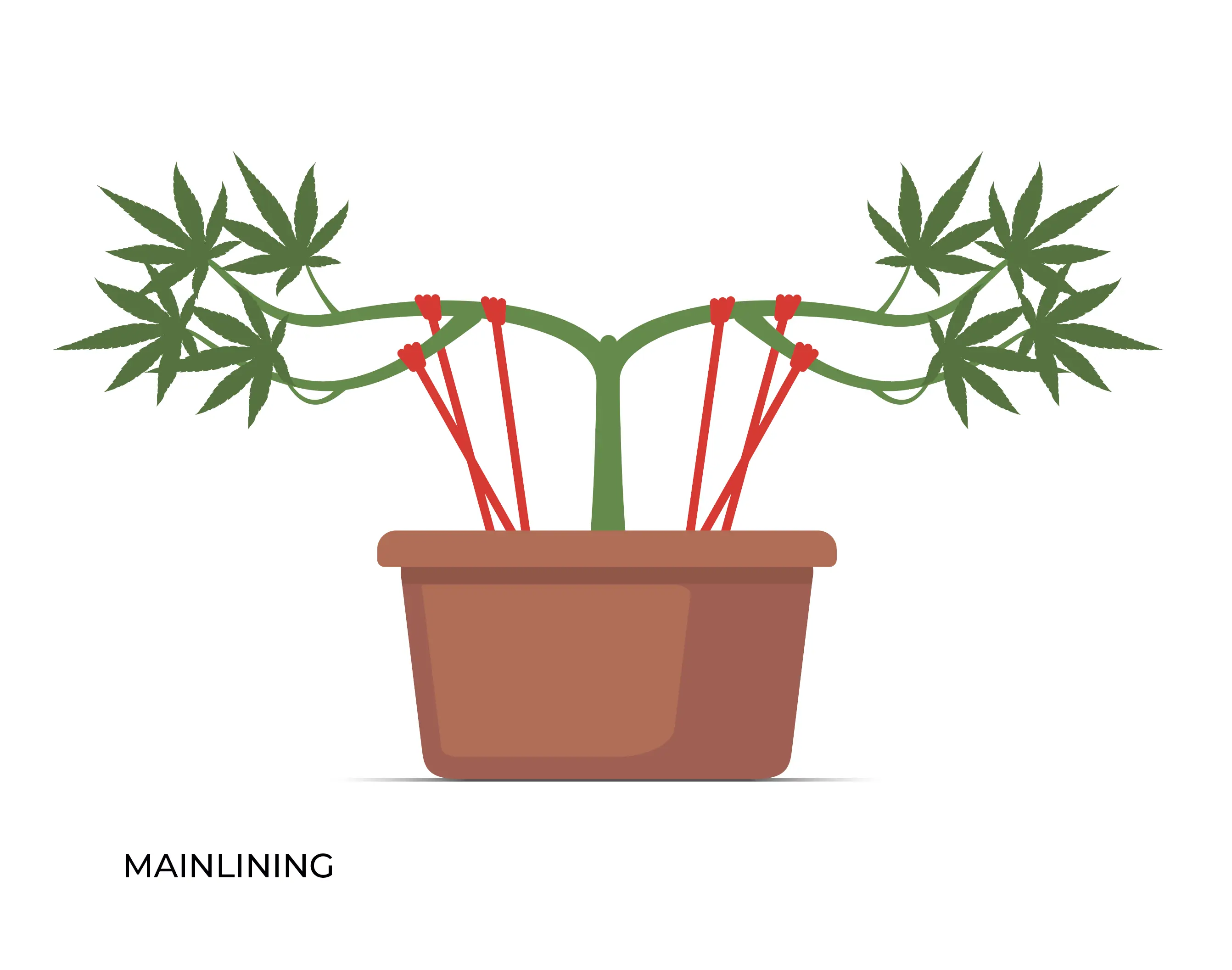
To explore this process in more depth, refer to this guide on mainlining cannabis plants with further reference to one of the instructive videos, on how to use the mainline technique, from the Skunkworks series.
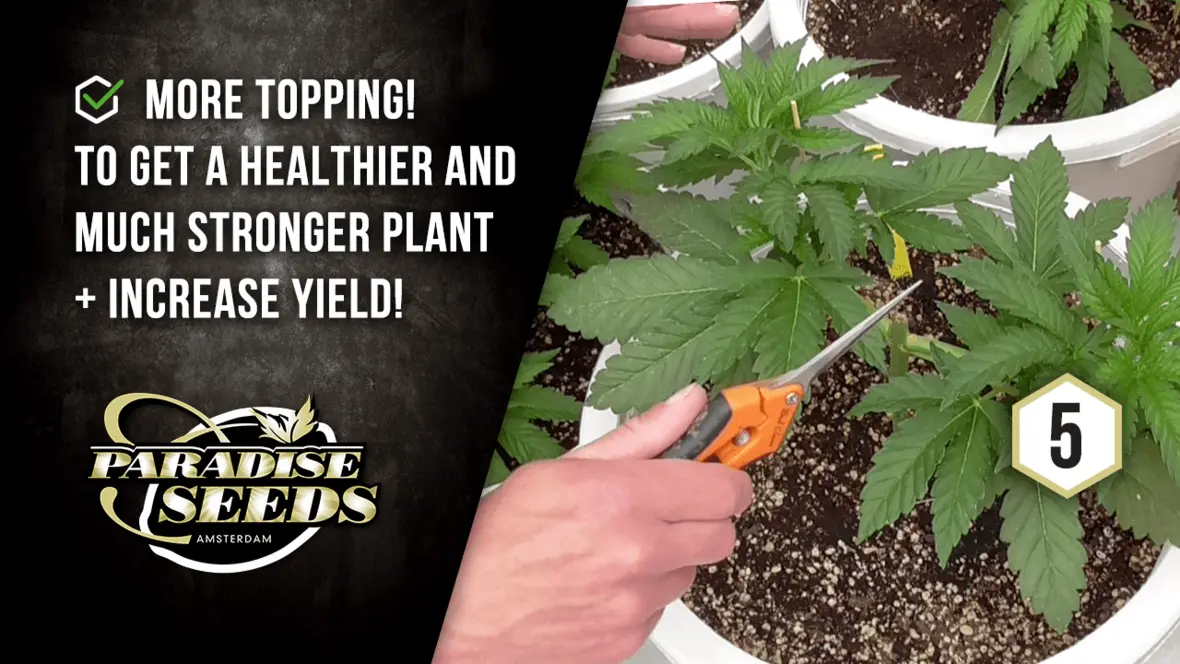
Super Cropping
The term super cropping sounds more ambitious than it actually is. In reality, this method involves pinching a plant stem and bending it in such a way that the inner lining breaks while the outer lining remains intact, thereby increasing its flexibility.
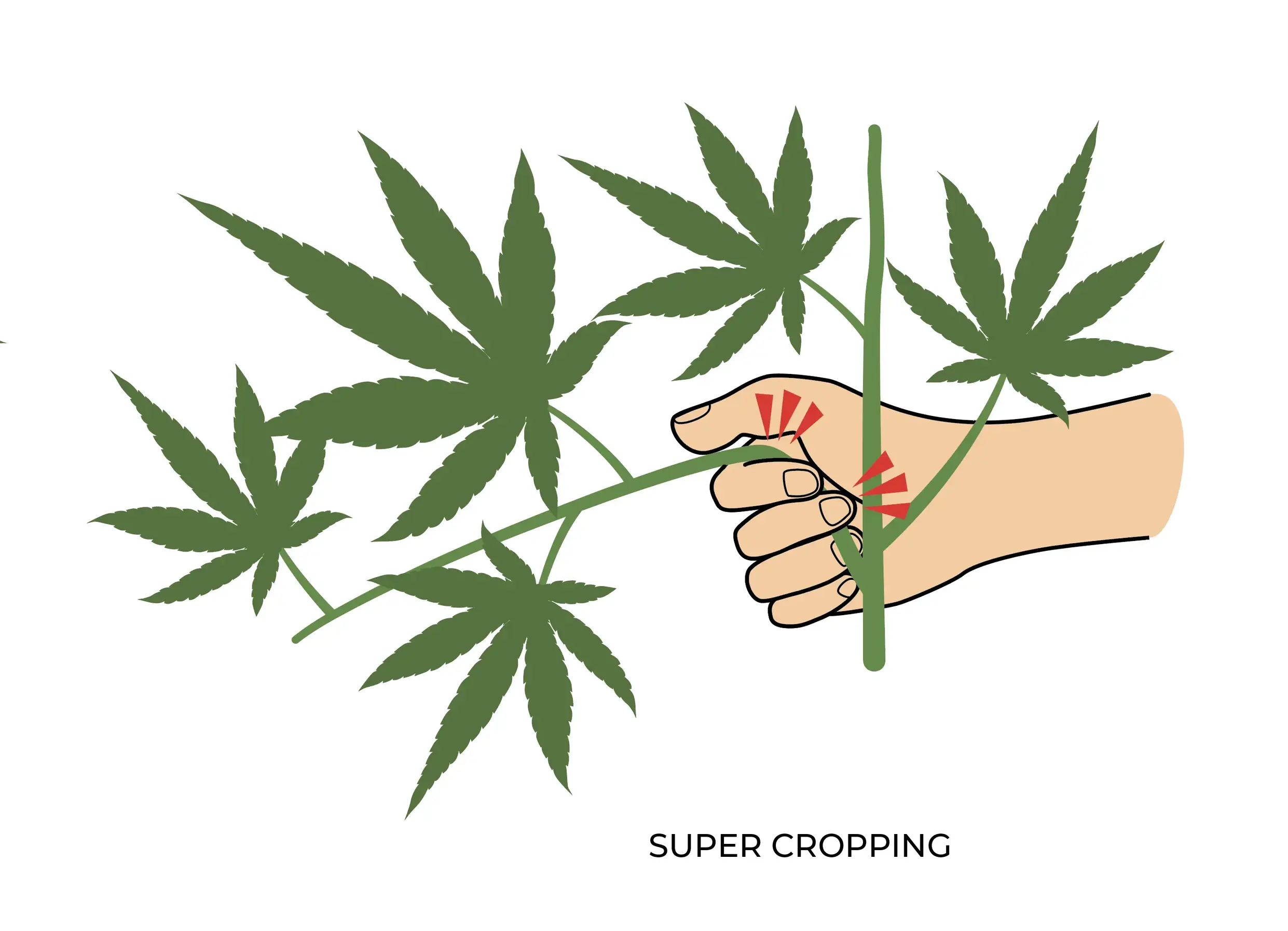
Why super crop a plant? In addition to promoting sideways growth and more medium sized buds, it is argued by some growers that this method of high stress training increases resin production in a plant, adding to more potency.
Obviously the danger is that too much pressure is exerted and the stem snaps. For an analysis of this pruning technique, with a guide to how to do it safely and effectively, consult this article on Best tips for super cropping cannabis plants.
Risks involved with using the HST training method
Before we take a look at specific risks, general advice for good practice, is to consider the plant before administering training:
- Is it healthy? Does it display all the signs of being a happy plant? That means robust growth and healthy green leaves with no signs of pest damage or discoloration caused by deficiencies. Stressed plants are more susceptible to pests and diseases.
- Allow sufficient time for recovery. HST techniques stress the plant significantly. Techniques like topping and fimming will expose the hollow stem and this needs time to heal (a hard callous will form as a seal), while super cropping will produce a hard ‘knuckle scar’. Let nature do its thing!
- Aspire for symmetry and balance. Keep that plant structure in balance so that extended lateral branches are uniform and show similar lengths.
HST risks to cannabis plant health
Over stressing the plant while using LST and HST training techniques will obviously impact its health so:
Avoid over-pruning a weed plant: The lollipopping technique is often used with both LST and HST methods and is basically the strategic removal of foliage. Once you start (like a bad haircut!) it’s difficult to stop and a big risk is taking off too many leaves/branches at the same time which can affect the plant’s ability to photosynthesize, thus restricting growth. Therefore, do it gradually, spread out over time, to aid the recovery period.
Avoid over-bending branches: With all manipulation movements, go slow, steady and gently to avoid snapping stems and branches.
Avoid HST and LST in flowering: While there are some exceptions, the rule for safety is to carry out training during vegetative growth – HST especially. Once in flowering the plant is more sensitive to stress.
Avoid ignoring the plant: Good cultivation of any plant relies on reading the signals a plant is giving. If you’re stressing the plant, it will let you know (drooping/wilting, discoloration of leaves, stunted growth).
LST training methods
When it comes to LST and HST cannabis training many of the tips around risks and handling tips are the same. However, if HST is the more brutal side of pruning, then LST is more gentle (and much more forgiving for the beginner).
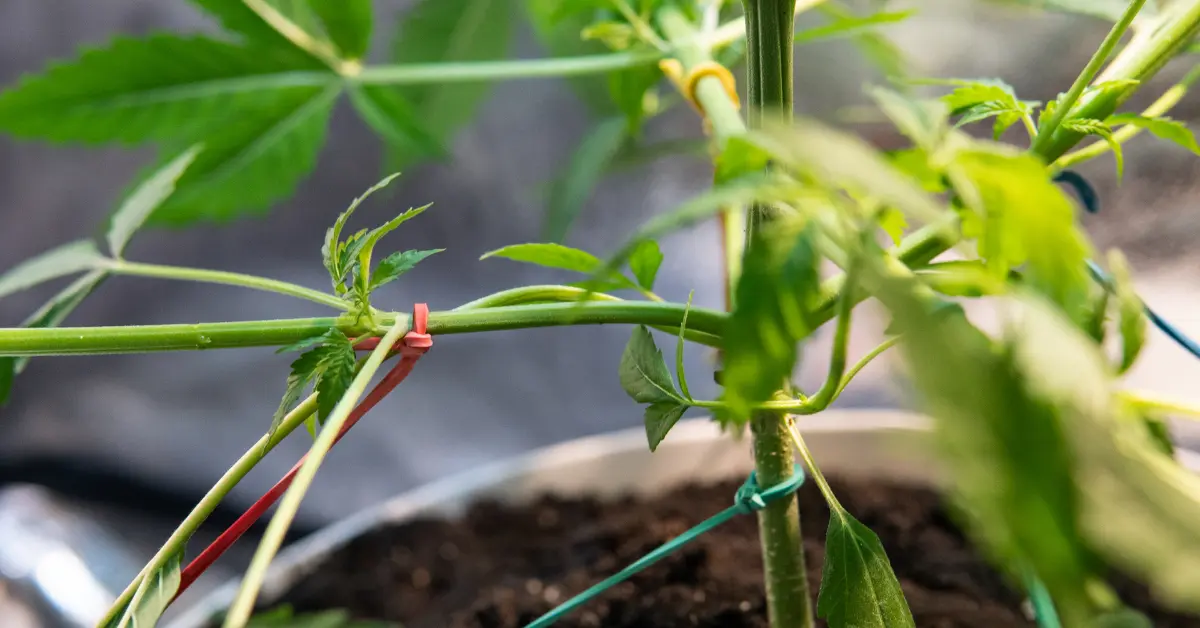
Why use LST for Cannabis Plants?
This cannabis growing technique is an extension of methods used in cultivation for many centuries to increase harvests – vines and fruit trees are a prime example, with branches trained to increase the surface area exposed to sunlight and good airflow.
The same principle applies to a cannabis plant. The standard vertical growth pattern will often produce big top buds, but flowers will get smaller further down due to lack of light.
Using LST to train a cannabis plant opens it up (to light and air), increasing bud development and promote evenly distributed bud sites with good air circulation, which prevents mold and mildew developing.
When do you start LST training?
Start early in the veg stage, when the seedling has 3 or 4 nodes. Often LST is combined with topping to encourage outward growth.
How do you use LST training for weed plants?
It starts very simply by gently bending the seedling stem in one direction and using flexible garden wire to hold in place, attaching the other end to the peg or skewer, so that it is anchored.
Be careful in the first stages – think of the plant like a bow, (gently bending in one direction). After a couple of days it will be easy to see how much the stem has grown and you can apply another anchor to extend that horizontal growth.
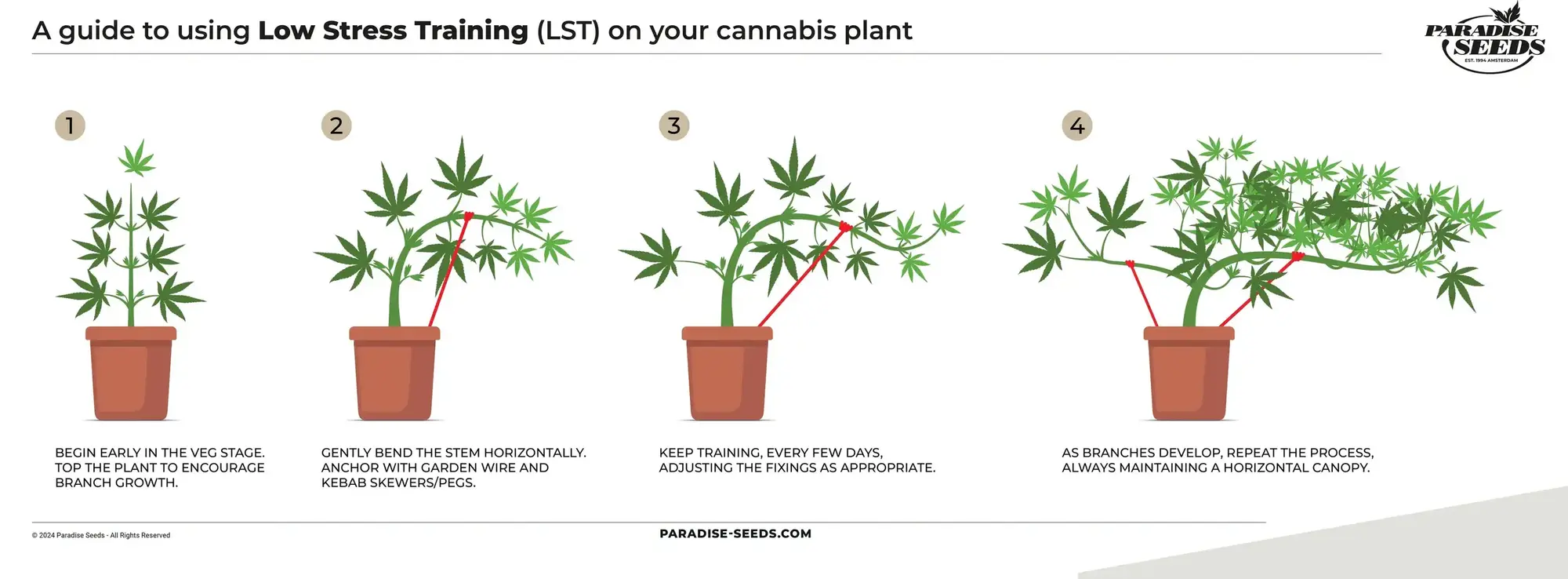
LST allows you to use your imagination!
The beauty of LST is you can train the plant to go anywhere! For example, you can grow a plant in a spiral shape. Let the stem grow outwards i.e. horizontally, until it reaches close to the edge of the pot and then bend it so that it follows that edge. As the plant grows, continue to shape the spiral.
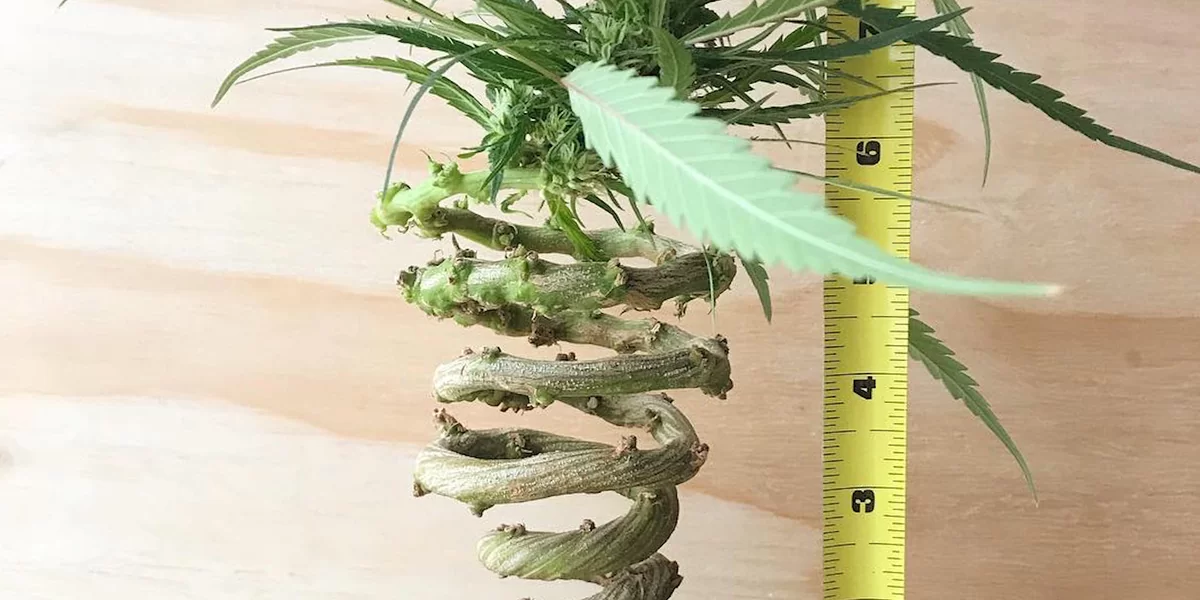
Is LST suitable for indoor and outdoor plants?
Yes! While the technique is popular with indoor growers looking to increase yields in small spaces, it is also a great technique to use outdoors in order to better manage the plant.
Increased light to bud sites will see better flower growth and improved airflow will help to prevent mold taking control of a plant.
To conclude
Using LST and HST cannabis training models is now a common practice embraced by many cultivators. The two training techniques both involve stressing a weed plant in order to achieve key performance enhancements.
These include better plant management, increased light exposure and better airflow and of course improving the quantity and quality of bud sites. For this reason the LST/HST training techniques contribute to substantial results and better yields.
While this article explores the technical aspects behind these methods, it should never be forgotten that plants ultimately answer to nature. The key recipe for success is to work with the plant, recognising when to push it and when to sit back and let it recover.

